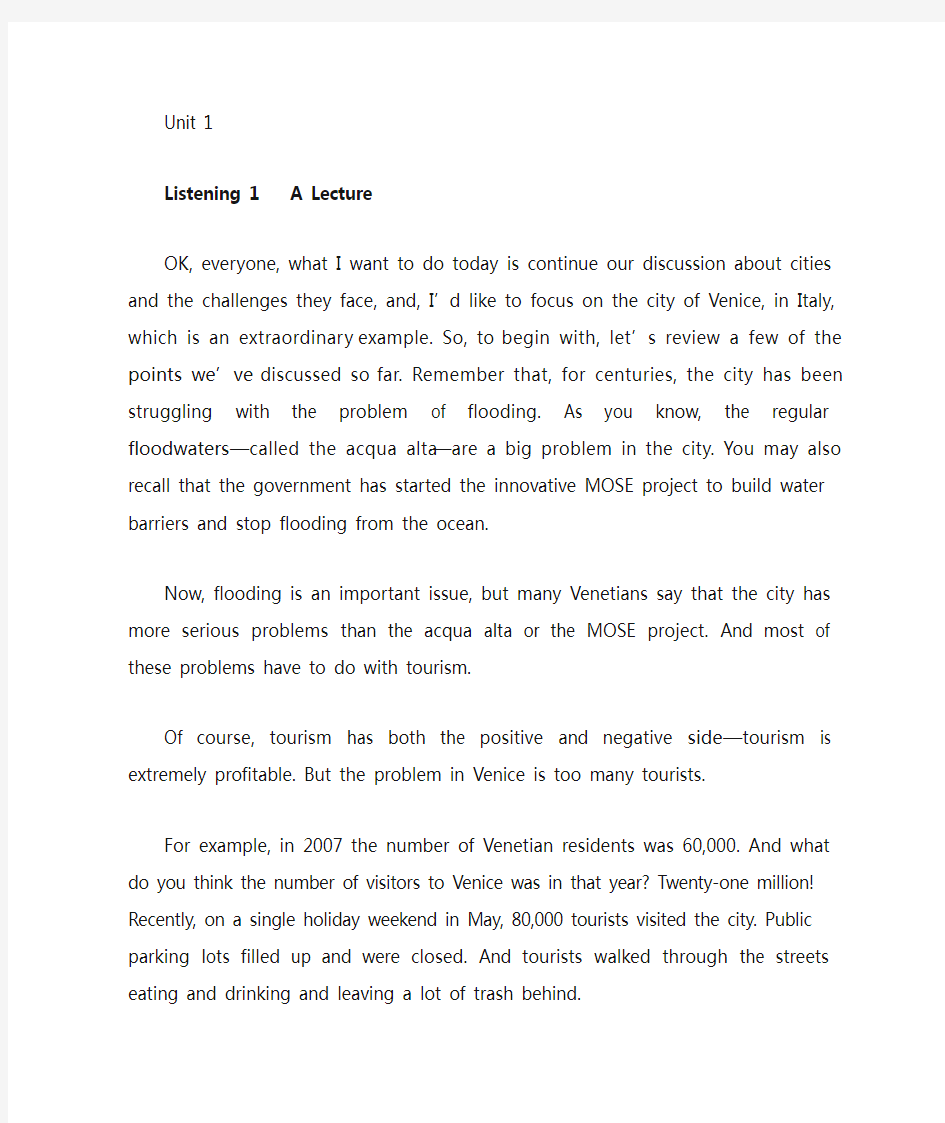国际交流英语视听说4听力原文加翻译U1-U8

- 1、下载文档前请自行甄别文档内容的完整性,平台不提供额外的编辑、内容补充、找答案等附加服务。
- 2、"仅部分预览"的文档,不可在线预览部分如存在完整性等问题,可反馈申请退款(可完整预览的文档不适用该条件!)。
- 3、如文档侵犯您的权益,请联系客服反馈,我们会尽快为您处理(人工客服工作时间:9:00-18:30)。
Unit 1
Listening 1 A Lecture
OK, everyone, what I want to do today is continue our discussion about cities and the challenges they face, and, I’d like to focus on the city of Venice, in Italy, which is an extraordinary example. So, to begin with, let’s review a few of the points we’ve discussed so far. Remember that, for centuries, the city has been struggling with the problem of flooding. As you know, the regular floodwaters—called the acqua alta—are a big problem in the city. You may also recall that the government has started the innovative MOSE project to build water barriers and stop flooding from the ocean.
Now, flooding is an important issue, but many Venetians say that the city has more serious problems than the acqua alta or the MOSE project. And most of these problems have to do with tourism.
Of course, tourism has both the positive and negative side—tourism is extremely profitable. But the problem in Venice is too many tourists.
For example, in 2007 the number of Venetian residents was 60,000. And what do you think the number of visitors to Venice was in that year? Twenty-one million! Recently, on a single holiday weekend in May, 80,000 tourists visited the city. Public parking lots filled up and were closed. And tourists walked through the streets eating and drinking and leaving a lot of trash behind.
The result is that Venice’s city services just can’t handle so many people. The city has to pay more and more money for garbage collection to clean up all of the trash. In addition, public transportation on the famous boats and gondolas is so crowded that Venetian residents can barely find room to get on.
Along with trash and crowded transportation, city residents also have to deal with higher prices for food and for housing. Food prices continue to rise around the city. Some cafés charge as much as 13 U.S. dollars for a soft drink! In the Rialto Market—an area with many shops and stores—some of the grocery stores have been replaced by souvenir shops, which means that Venetians have fewer places to buy their groceries. In popular tourist areas, rent has almost tripled, and many small local businesses—for example, toy stores and hardware stores—can’t afford to pay.
Let me add that there is a serious housing problem in Venice. At one time, there were regulations making it illegal to convert residential buildings into hotels. But a law in 1999 removed those regulations, and the housing problem got even worse. Since then, the number of hotels and guesthouses has increased by 600 percent, and the number of houses that are available for local residents has gone down.
These days, housing is only affordable for the very rich or for people who already own houses because they’ve been passed down by family. Young Venetians simply can’t afford to buy any property in the city. This has forced a huge number of Venetian residents to move out of the city. Thirty years ago, the population of Venice was around 120,000. Now it’s less than 60,000.
So, why does Venice continue to encourage tourism when it causes so many problems? Mainly it’s because tourism in Venice generates more than two billion U.S. dollars a year in revenue—and many think that the amount is much higher.
Also, there’s a lot of financial pressure on Venice. The cleaning of canals, restoration of old structures, and the MOSE project are all very expensive. Tourism brings in money to help the city solve these problems.
Another point I want to make is that many people in Venice have jobs related to tourism. As more
